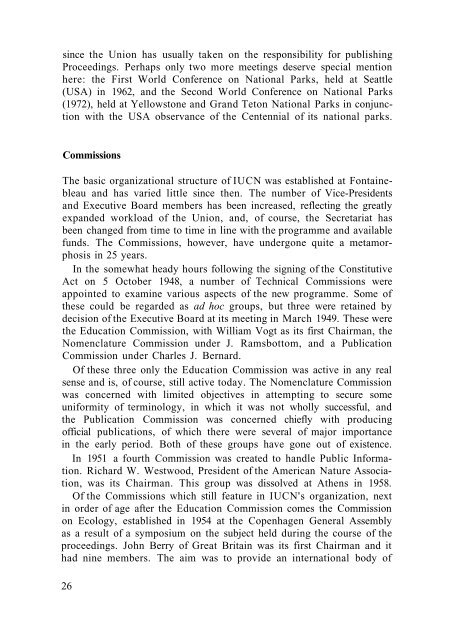1973 iucn yearbook
1973 iucn yearbook
1973 iucn yearbook
You also want an ePaper? Increase the reach of your titles
YUMPU automatically turns print PDFs into web optimized ePapers that Google loves.
since the Union has usually taken on the responsibility for publishing<br />
Proceedings. Perhaps only two more meetings deserve special mention<br />
here: the First World Conference on National Parks, held at Seattle<br />
(USA) in 1962, and the Second World Conference on National Parks<br />
(1972), held at Yellowstone and Grand Teton National Parks in conjunction<br />
with the USA observance of the Centennial of its national parks.<br />
Commissions<br />
The basic organizational structure of IUCN was established at Fontainebleau<br />
and has varied little since then. The number of Vice-Presidents<br />
and Executive Board members has been increased, reflecting the greatly<br />
expanded workload of the Union, and, of course, the Secretariat has<br />
been changed from time to time in line with the programme and available<br />
funds. The Commissions, however, have undergone quite a metamorphosis<br />
in 25 years.<br />
In the somewhat heady hours following the signing of the Constitutive<br />
Act on 5 October 1948, a number of Technical Commissions were<br />
appointed to examine various aspects of the new programme. Some of<br />
these could be regarded as ad hoc groups, but three were retained by<br />
decision of the Executive Board at its meeting in March 1949. These were<br />
the Education Commission, with William Vogt as its first Chairman, the<br />
Nomenclature Commission under J. Ramsbottom, and a Publication<br />
Commission under Charles J. Bernard.<br />
Of these three only the Education Commission was active in any real<br />
sense and is, of course, still active today. The Nomenclature Commission<br />
was concerned with limited objectives in attempting to secure some<br />
uniformity of terminology, in which it was not wholly successful, and<br />
the Publication Commission was concerned chiefly with producing<br />
official publications, of which there were several of major importance<br />
in the early period. Both of these groups have gone out of existence.<br />
In 1951 a fourth Commission was created to handle Public Information.<br />
Richard W. Westwood, President of the American Nature Association,<br />
was its Chairman. This group was dissolved at Athens in 1958.<br />
Of the Commissions which still feature in IUCN's organization, next<br />
in order of age after the Education Commission comes the Commission<br />
on Ecology, established in 1954 at the Copenhagen General Assembly<br />
as a result of a symposium on the subject held during the course of the<br />
proceedings. John Berry of Great Britain was its first Chairman and it<br />
had nine members. The aim was to provide an international body of<br />
26

















